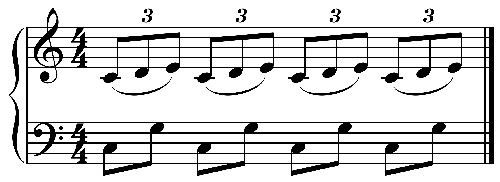Get more rhythmically out of your playing with Bill Plake’s New E-Book
Bill Plake’s “Essential Polymeter Studies In 4/4”


Introduction
Before I talk about Bill’s e-book Essential Polymeter Studies In 4/4, I thought you might want to find out more about the author. Bill Plake is “a saxophonist, flutist, composer, and an Alexander Technique teacher, certified by the American Society for the Alexander Technique (AmSAT). He is also certified as a personal fitness trainer through the National Academy of Sports Medicine (NASM).”
Over Bill’s 35 years as a musician, his work is “primarily in the world of modern jazz and other conceptually unique forms of improvisation. A few of the artists he has worked with to date are: Charlie Haden, Nels Cline, Vinny Golia, Jaki Byard, James Newton, Larry Koonse, Michael Vlatkovich, John Carter, Steuart Liebig, Matt Otto, Harry Scorzo, Chris Garcia, Billy Mintz, and Kim Richmond.”
Bill, “has been on the faculty of the American Musical and Dramatic Academy in Los Angeles, teaching the Alexander Technique to actors, singers and dancers. In addition, he teaches the Alexander Technique as a guest lecturer and adjunct at California Institute of the Arts, and at Pomona College.” While teaching, Bill is always looking for new ways to practice: “expanding his rhythmic vocabulary, challenging his sense of form, finding new ways of organizing melodies, thinking differently about tonality, and ultimately increasing his freedom and fluency.”
Book Overview
The Essential Polymeter Studies In 4/4 is a jazz e-book that specifically focuses on rhythm and time. Plake discusses both polyrhythm and polymeter and how “Polyrhythm involves playing (or implying) two or more distinct beats simultaneously (e.g., three beats against two, as in the case of an eighth note triplet being played against two regular eighth notes), while polymeter involves implying two or more metric subdivisions at the same time (e.g., 5/4 over 4/4).”
The book contains nearly 150 pages of notated exercises with almost each exercise transcribed in all 12 keys. Plake decided to focus on some of the most common polymetric subdivisions in 4/4 time and how they apply to improvisation. This book consists of the following:
- Chapter 1 demonstrates 3/4 over 4/4
- Chapter 2 demonstrates 5/8 (5/4) over 4/4
- Chapter 3 demonstrates 7/8 (7/4) over 4/4,
- Chapter 4 discusses the displacement of 2/4.
While working through each Chapter, I kept referring back to Plake’s three suggested guidelines or must-do’s if you want to gain a better understanding of polymeter. The most important of these three for me was to practice with a metronome. The metronome helped me hear both meters simultaneously and differentiate each exercise. In addition to the metronome, while working through the e-book, Plake recommends that you should always know where the downbeat of one is in every measure you play, while also recognizing how each polymetric subdivision returns to its starting point.
I would recommend writing these 3 steps down before practicing each chapter to make sure you are getting the most out of the exercises and incorporating the material into your playing.
After completing the e-book, I decided to refer back to Plake’s goals for why he developed the book and see if I was on the right track before I went thru the exercises a second time to see how much I had retained from practicing.
Some of the benefits that Plake listed in his e-book are as follows:
- Establish a clear understanding of basic odd-metered subdivision cycles over 4/4, and how these cycles return to their starting point.
- Increase your confidence and improve your ability to improvise in odd meters.
- Deepen your sense of structure and form as you improvise over chord changes (and other closed-ended forms).
- Develop more tools to create tension and release as you improvise, through time, feel and rhythm.
- Broaden your rhythmic imagination in both odd and even meters as you improvise.
- Discover surprisingly new ways to re-organize the harmonic/melodic materials you already know.
- Improve your rhythmic sight reading, and your time.
- Fundamentally transform your phraseology when improvising in any idiom.
I noticed progress in regards to #1, #6 and #7. I believe I will achieve the other benefits from this e-book by practicing the exercises and using a metronome more and more.
Conclusion
When I finished Essential Polymeter Studies In 4/4, I would have to agree with Plake that this e-book would be best suited for the intermediate to advanced jazz musician due to the topics discussed and basic knowledge required.
I was overall impressed by how Plake laid out the exercises as well as setup guidelines for practicing the material. The guidelines are essential if you are going to gain a better understanding of polymeter. I know I will continue to work thru this e-book more and more to better understand the topics discussed in each chapter and most importantly incorporate these ideas into my playing.
If you have any question in regards to the book, feel free to check out billplakemusic.org
Essential Polymeter Studies In 4/4
http://billplakemusic.org/my-books/essential-polymeter-studies-in-44/





